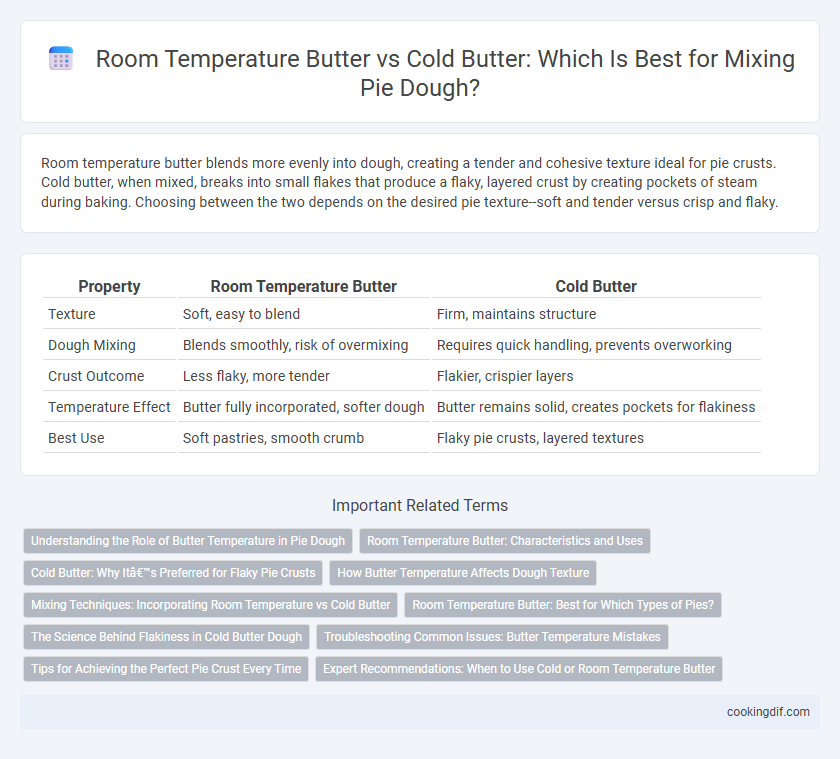Room temperature butter blends more evenly into dough, creating a tender and cohesive texture ideal for pie crusts. Cold butter, when mixed, breaks into small flakes that produce a flaky, layered crust by creating pockets of steam during baking. Choosing between the two depends on the desired pie texture--soft and tender versus crisp and flaky.
Table of Comparison
| Property | Room Temperature Butter | Cold Butter |
|---|---|---|
| Texture | Soft, easy to blend | Firm, maintains structure |
| Dough Mixing | Blends smoothly, risk of overmixing | Requires quick handling, prevents overworking |
| Crust Outcome | Less flaky, more tender | Flakier, crispier layers |
| Temperature Effect | Butter fully incorporated, softer dough | Butter remains solid, creates pockets for flakiness |
| Best Use | Soft pastries, smooth crumb | Flaky pie crusts, layered textures |
Understanding the Role of Butter Temperature in Pie Dough
Butter temperature significantly impacts the texture and flakiness of pie dough, with room temperature butter allowing easier incorporation and more cohesive gluten development. Cold butter, when mixed into dough, creates pockets of fat that melt during baking, producing a flaky, tender crust by preventing excessive gluten formation. Selecting the appropriate butter temperature depends on the desired pie crust outcome, affecting both dough handling and final crumb structure.
Room Temperature Butter: Characteristics and Uses
Room temperature butter is soft and malleable, allowing it to blend seamlessly with flour to create a tender, cohesive dough. Its pliability helps evenly distribute fat throughout the mixture, resulting in a flaky and light pie crust. Using room temperature butter is ideal for creaming methods and achieving optimal texture in pastries.
Cold Butter: Why It’s Preferred for Flaky Pie Crusts
Cold butter remains solid during dough mixing, creating small pockets of fat that melt during baking, resulting in a flaky texture. Its low temperature prevents premature gluten development, ensuring a tender crust rather than a tough one. Using cold butter helps achieve the ideal layered structure essential for classic pie crust flakiness.
How Butter Temperature Affects Dough Texture
Room temperature butter blends smoothly with flour, creating a tender, flaky dough by evenly distributing fat throughout the mixture. Cold butter, when mixed into dough, remains in small solid pieces that melt during baking, producing distinct layers and a crispier, flakier texture. The temperature of butter directly influences dough consistency, affecting crumb structure and overall pie crust quality.
Mixing Techniques: Incorporating Room Temperature vs Cold Butter
Room temperature butter blends seamlessly into dough, creating a smooth, cohesive mixture ideal for tender pie crusts, while cold butter retains distinct pockets of fat that produce flakier, layered textures when baked. When mixing dough, incorporating room temperature butter requires gentle folding and creaming to avoid overworking gluten, whereas cold butter demands quick cutting or rubbing into flour to maintain its solid consistency. Selecting the appropriate butter temperature directly influences the dough's elasticity, crumb, and final pie crust structure.
Room Temperature Butter: Best for Which Types of Pies?
Room temperature butter is ideal for pie doughs that require a tender, flaky texture, such as shortcrust or pate brisee, because it incorporates more evenly into flour, creating a cohesive yet delicate dough. This butter consistency enables better mixing and rolling without tearing the dough, which is essential for fruit pies or custard-based pies where a softer crust complements the filling. Using room temperature butter also helps prevent overworking the dough, preserving its crumbly quality essential for pies like apple, cherry, and pumpkin.
The Science Behind Flakiness in Cold Butter Dough
Cold butter creates steam pockets as it melts during baking, causing the dough to lift and form flaky layers. Room temperature butter incorporates more fully into the dough, resulting in a tender but less flaky texture. The key to optimal flakiness in pie crust lies in maintaining cold butter pieces, which generate distinct layers as they melt.
Troubleshooting Common Issues: Butter Temperature Mistakes
Using cold butter in dough mixing often causes uneven dough texture and difficulty blending, leading to brittle crusts that lack flakiness. Room temperature butter allows for better incorporation, creating a tender, pliable dough that traps steam effectively for a flaky result. Avoiding overly soft or melting butter is crucial, as it can make the dough greasy and tough, compromising the pie's structure.
Tips for Achieving the Perfect Pie Crust Every Time
Using cold butter for pie dough creates flakier crusts because the solid fat leaves small pockets during baking, enhancing texture. Room temperature butter blends more thoroughly with flour, resulting in a tender but less flaky crust, ideal for those seeking a softer bite. For the perfect pie crust every time, chill your dough before baking to solidify the butter and maintain its structure.
Expert Recommendations: When to Use Cold or Room Temperature Butter
Expert recommendations emphasize using cold butter for dough mixing when seeking a flaky texture, as the solid fat creates distinct layers during baking. Room temperature butter is preferred for creamier, more elastic doughs that require thorough mixing and uniform texture. Choosing the appropriate butter temperature depending on the desired pie crust texture enhances the final product's quality and consistency.
Room temperature butter vs cold butter for dough mixing Infographic

 cookingdif.com
cookingdif.com